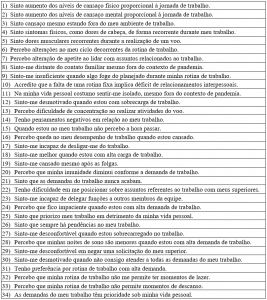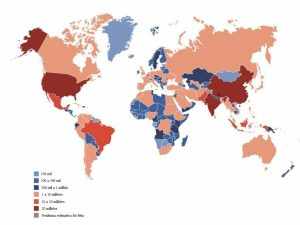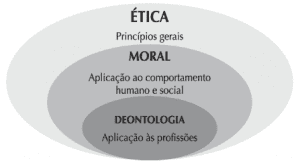REVIEW ARTICLE
MIGNONI JÚNIOR, Larri Antonio [1], LUCAS, Ivone Aparecida [2]
MIGNONI JÚNIOR, Larri Antonio. LUCAS, Ivone Aparecida. Fatigue risk management in aviation operations. Revista Científica Multidisciplinar Núcleo do Conhecimento. Year. 08, Ed. 06, Vol. 05, pp. 42-57. June 2023. ISSN: 2448-0959, Access link: https://www.nucleodoconhecimento.com.br/science-aeronautics/aviation-operations, DOI: 10.32749/nucleodoconhecimento.com.br/science-aeronautics/aviation-operations
ABSTRACT
Fatigue accounts for 15% to 20% of human-related accidents. The increasing annual demand for air transportation has raised concerns in this 24/7 activity, as the crew ends up working irregular hours to meet this demand. Current regulations limit crew working hours to minimize fatigue risks, but do not eliminate them. Scientific studies reveal multiple contributing factors leading to crew fatigue, dispelling the old paradigms that fatigue resulted solely from a linear accumulation of working hours. Based on the findings of these scientific studies, a new support tool is created and presented, with the primary goal of mitigating fatigue-related effects and enhancing crew alertness to operate at a satisfactory performance level. This work aims, through a literature review, to expose the risks associated with fatigue in aviation operations and introduce the fatigue risk management system as a competitive lever to achieve a balance between safety and productivity.
Keywords: Safety, Pilots, Strategies, Fatigue.
1. INTRODUCTION
By its very nature, humans make mistakes. Therefore, it comes as no surprise that 70% to 80% of fatal aviation accidents are caused by human error (Wiegmann; Shappel, 2001). Fatigue accounts for approximately 15% to 20% of this total (Akerstedt et al., 2003) and is considered by the International Civil Aviation Organization (ICAO, 2011) as the primary human hazard factor, as it affects most aspects of a crew member’s ability to perform their job.
Managing safety risks associated with fatigue in a work environment requires a clear definition of fatigue. According to ICAO (2011), fatigue is defined as:
Um estado fisiológico de redução da capacidade de desempenho mental ou física resultante de perda de sono ou longo tempo sem dormir, fase circadiana, ou carga de trabalho (atividade mental e/ou física) que pode prejudicar o estado de alerta de um membro da tripulação e a capacidade de operar com segurança uma aeronave ou desempenhar funções relacionadas com a segurança. (tradução nossa). (p. 1-1)
The Federal Aviation Administration (FAA, 2013) defines fatigue as a complex state characterized by a lack of attention and a reduction in physical and mental performance, often accompanied by drowsiness. Changes are observed in many aspects of performance, including increased reaction time, lapses in attention, slowed cognitive task speed, reduced situational awareness, and decreased motivation.
Several factors contribute to the development of fatigue: the time of day when the service is performed, loss of sleep before starting work, and long periods of wakefulness during the workday (Akerstedt et al., 2003). Studies show that sleep loss produces psychomotor deficits equivalent to those caused by alcohol consumption at or above the legal limit. Being awake for more than 16 consecutive daylight hours can lead to psychomotor performance deficits equivalent to blood alcohol levels of 0.05% to 0.1% (Durmer; Dinges, 2005).
Based on accident analyses, the National Transportation Safety Board (NTSB) recommended that the FAA include, as part of training, a program to educate pilots about the detrimental consequences of fatigue and strategies to avoid it and mitigate its effects (NASA, 2002). According to NASA research (2002), 61% of pilots described crew fatigue as a common occurrence in regional operations. Moreover, 85% rated fatigue as a moderate or serious safety issue when it occurs. Nearly three-quarters (71%) admitted to having dozed off at some point during the flight.
Risk management strategies need to be developed to reduce the negative effects associated with human fatigue within aviation operations. This risk must be addressed through a protection system for users and all involved parties. Since a company’s ultimate goal is the production of products or services, production and protection goals must be balanced. This balance is delicate, as excessive production can compromise safety, and excessive safety can jeopardize the company’s financial performance (Stolzer; Halford; Goglia, 2011).
2. CURRENT SCENARIO
The aviation industry is one of the fastest-growing sectors in the global scenario today. ICAO (2023) estimated a 47% increase in the number of passengers transported in 2022 compared to 2021, while Revenue Passenger-Kilometers (RPK) increased by about 70% in the same period. This demonstrates a rapid recovery of the aviation industry following the COVID-19 pandemic. In terms of annual revenue, ICAO (2023) estimated a 50% growth between 2021 and 2022. According to the International Air Transport Association (IATA, 2017), the air transport market in Brazil is estimated to grow by 105% in the next 20 years, resulting in an additional 106 million passengers by 2037.
To meet this growing demand, the crew ends up being subjected to irregular working hours, representing a significant risk to flight safety. The National Business Aviation Association (NBAA, 2019) noted that “some long trips can keep the crew awake for more than 20 hours, while fast-paced and multi-leg journeys can be physically exhausting.”
It is important to emphasize that, within the aviation context, safety is the state in which the possibility of harm to people or property is reduced and maintained at or below an acceptable level through a continuous process of hazard identification and risk management (ICAO, 2011).
In the early days of aviation, fatigue was primarily seen in terms of the total flight time and the intensity of the workload (WIENER; NAGEL, 1988).
The traditional regulatory approach to managing crew fatigue has been to set maximum limits for daily, monthly, and annual service and flight hours, requiring minimum breaks within and between duty periods (ICAO, 2011).
According to the FAA (2013), conventional regulations following this model reduce but do not eliminate the conditions contributing to fatigue. They are based on the assumption that fatigue accumulates linearly and do not consider the interactions of sleep loss and circadian rhythms.
ICAO (2011) describes this paradigm as stemming from a long history of working-hour limits dating back to the industrial revolution.
There is a notable consensus in scientific evidence regarding sleep and alertness parameters in relation to aviation operations. Such is this consensus that leading scientists have formulated a document with general recommendations on how these parameters should be taken into account in regulation development (AKERSTEDT et al., 2003).
Recently, the concept of Fatigue Risk Management Systems (FRMS) has emerged, containing recommendations for managing human fatigue risk in aviation operations. “The FRMS seeks to achieve a realistic balance between safety, productivity, and costs” (ICAO, 2011).
The European Organisation for the Safety of Air Navigation (EUROCONTROL, 2012) reported that airlines currently want to use FRMS as a means to increase safety while expanding their businesses. In this highly competitive market, there are few competitive levers available to the company. Occupational alert management is one of the few that offers improved safety and business together.
The first airlines to adopt this fatigue risk management system were Air New Zealand and EasyJet. Around the world, some of the largest and most competitive airlines are exploring and adopting FRMS within their operations. Many companies are also planning to implement this system, including Delta, Continental-United, US Air, Malaysia, Qantas, Emirates, GOL (Brazil), LAN (Chile and Argentina), Etihad, and DHL. “This new concept is particularly relevant in the aviation industry, which is unique in its combination of 24/7 operations with transmeridian flights” (ICAO, 2011).
3. THE CIRCADIAN RHYTHM
For a better analysis, it is important to know that, in humans, the circadian rhythm is the daily behavioral and physiological alteration in a person. These changes are controlled by a biological clock located in the brain (FAA, 2013). It is an ancient adaptation to life during the 24 hours of the day produced by the rotation of the Earth.
Therefore, sleeping at night is not just a social agreement. This is programmed by the circadian biological clock. Even very old types of living organisms have something equivalent, which means that the circadian biological clock has existed for several billion years (ICAO, 2011).
Through this biological clock, daily cycles of sleeping or waking, temperature, digestion, performance, hormones, etc., are coordinated. Without any information from the environment, the biological day is approximately 24 hours. Since the beginning of the industrial revolution, we have developed a cultural environment in which there is increasing pressure for operations and services around the clock. The timely assumption that we can and do perform equally at any time of day or night underlies many activities in our society (ROSEKIND et al., 2002).
According to Akerstedt et al. (2003), scientific studies show that night work is particularly vulnerable to severe fatigue. The longer this working period is extended, the greater the pressure from sleep. There is strong evidence that crew members fall asleep, voluntarily or involuntarily, in the aircraft cabin.
The explanation for this is the production of a hormone, known as melatonin, produced by the pineal gland located in the brain, behind the brain. This gland has a circadian rhythm, being inhibited by light and activated in the dark. Thus, the concentration of the hormone melatonin increases at night and decreases during the day (RAW; KRASILCHIK; MENNUCCI, 2001). In humans, sleep begins with an increase in melatonin and, consequently, a reduction in body temperature (RAJARATNAM; ARENDT, 2001).
There are two periods of maximum drowsiness during the 24 hours of the day when there is an increase in melatonin production and a decrease in body temperature. According to Rosekind et al. (2002), between 3 am and 5 am, there is a low point in temperature, performance, and alertness (Figure 1). During this time, the brain triggers sleep and drowsiness. Another period of drowsiness is approximately between 3 pm and 5 pm. These windows can be used to schedule a sleep or nap period because the brain provides a greater opportunity for sleep.
Most people experience an afternoon wave of drowsiness, but according to Rajaratnam and Arendt (2001), the increase in accidents in the afternoon is small compared to the increase in nighttime accidents.
According to Rosekind et al. (2002), in general, humans are physiologically programmed to be awake during the day and sleep at night.
According to Transport Canada (2007), it can be concluded that the circadian rhythm influences the quantity and quality of sleep. For example, sleep obtained during the day is of poorer quality compared to sleep acquired at night when the body is programmed to sleep.
Figure 1 – Circadian Rhythm of Melatonin Concentration (A), Body Temperature (B), Alertness (C), and Reaction Time (D)
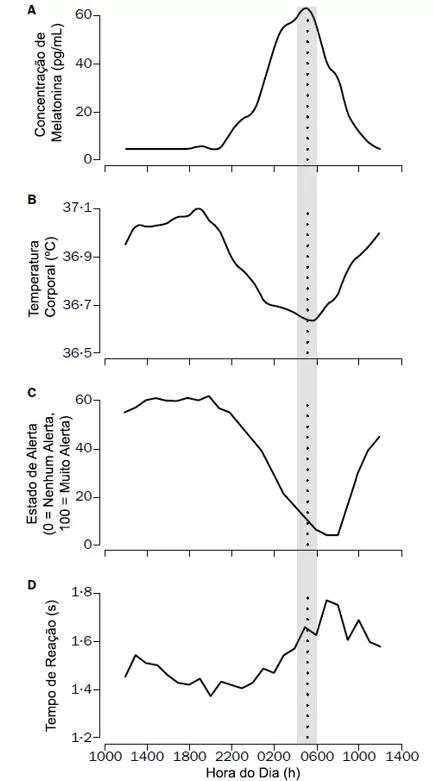
4. LOSS OF SLEEP OR LONG TIME WITHOUT SLEEP
The loss of sleep or prolonged time without sleep is becoming increasingly common in modern society due to a wide range of factors, including medical conditions, sleep disorders, work demands, and social and household responsibilities (DURMER; DINGES, 2005).
Reduced or degraded sleep can significantly decrease or impair performance and alertness. Sleep loss affects every aspect of human performance, including memory, vigilance, decision-making, mood, reaction time, as well as an increase in errors and a reduction in motivation and relaxation. There is no consensus on the extent of impairment resulting from a specific amount of sleep loss (NERI; DINGES; ROSEKIND, 1997; RAJARATNAM; ARENDT, 2001).
According to Rajaratnam and Arendt (2001), with the growing economic and social demand, we are increasingly engaging in a 24-hour society. About 20% of the population works outside regular hours, making it clear that sleep loss is the most important immediate consequence of shift work.
Neri, Dinges, and Rosekind (1997) reported that sleep is a vital physiological function, as critical to human survival as food, water, and oxygen. It is very difficult to deprive these basic physiological needs.
For Akerstedt et al. (2003), sleep is a state of significant physiological regeneration. The optimal amount of sleep for complete recovery is around 8.5 hours, although a loss of 1 to 2 hours has little significant effect on fatigue or performance. A deficit of more than 2 hours results in increased fatigue and decreased performance in most individuals.
However, over time, sleep loss can accumulate a sleep debt. One hour less than is needed for a night’s sleep over 7 consecutive nights would result in an accumulated sleep debt of 7 hours, equivalent to a night of lost sleep over the course of a week (NERI; DINGES; ROSEKIND, 1997).
In addition to sleep loss, another contributing factor to fatigue is the extended period without sleep, and according to Rajaratnam and Arendt (2001), after 17-19 hours of continuous wakefulness, there is a decrease in performance equivalent to, or worse than, a blood alcohol concentration of 0.05%. Above 20-25 hours of wakefulness, there will result in a reduction in performance equivalent to a blood alcohol concentration of 0.1% (Figure 2).
Figure 2 – Comparison of the effect of blood alcohol concentration and hours of wakefulness on task performance
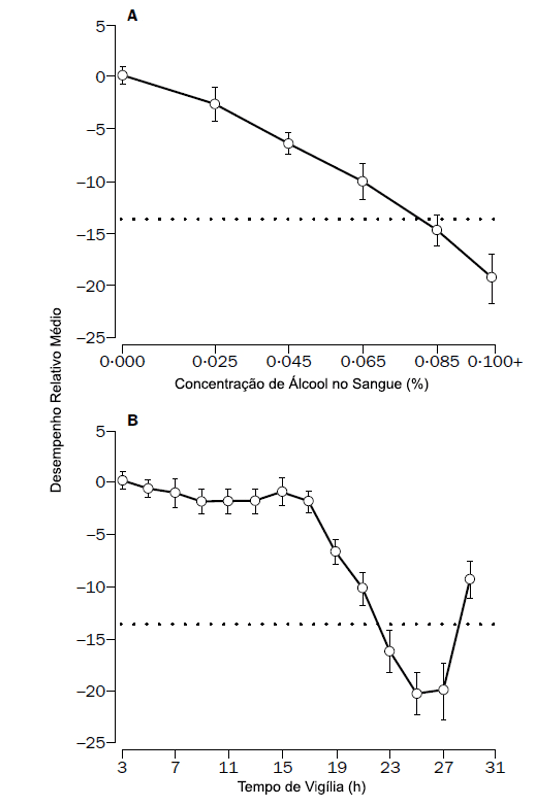
NASA (2002) states that not only the quantity of sleep is important, but also the quality of sleep. If an individual has 8 hours of sleep, but their sleep is interrupted several times, upon waking up, the person feels as if they had only a few hours of sleep. Environmental factors (noise, temperature, lighting, etc.), medications, and alcohol can interfere, reducing the quantity and quality of sleep.
5. JET LAG SYNDROME OR TIME ZONE CHANGE SYNDROME
Another relevant factor to consider is the occurrence of the time zone change syndrome, known as Jet Lag, which is passing through several time zones, causing a disruption in the Zeitgeber[3], in other words, a diachrony of the body with a new time zone. After a transcontinental flight, not only will the circadian clock be out of sync with the local Zeitgeber, but also physiological functions will be out of sync with each other. However, gradually, the circadian clock resynchronizes within the new time zone. (ROSEKIND et al., 2002).
The symptoms of Jet Lag include daytime fatigue, difficulty sleeping at night (after eastward flights) or early awakening (after westward flights), disrupted nighttime sleep, impaired daytime alertness or performance, gastrointestinal problems, loss of appetite, and inappropriate timing for physiological needs (RAJARATNAM; ARENDT, 2001).
According to ICAO (2011), the greater the number of time zones crossed, the longer it takes for the body to adapt to the new environment. However, the situation experienced by the crew is different from passengers who, most of the time, plan to spend more time at the destination, fully adapting to the new time zone. According to NASA (2001), crew members do not spend enough time in a new time zone for the circadian clock to synchronize with the new time. Usually, layovers at each destination range from 1 to 2 days. Afterward, the crew is called to perform a return flight to the home location, followed by a return to their city of origin.
According to ICAO (2011), the degree of adaptation depends not only on the number of time zones crossed but also on the direction of the flight (faster after westward flights) and how much the biological clock is exposed to the 24-hour schedule of the new time zone (daylight, sleep, and waking at local times, etc.).
6. THE FATIGUE RISK MANAGEMENT SYSTEM
The FRMS (Fatigue Risk Management System) approach is designed to apply this new knowledge from fatigue science and safety science. It is intended to provide an equivalent or enhanced level of safety while offering greater operational flexibility (ICAO, 2011).
EUROCONTROL (2012) describes the FRMS as an alternative to using prescriptive rules when managing risks resulting from reduced alertness while on duty.
According to FAA (2013), structurally, an FRMS consists of processes and procedures for measuring, modeling, managing, mitigating, and reevaluating the risk of fatigue in a specific operational environment. It is more than a collection of tools; it is a management process based on organizational policies and procedures that implement a systems approach to fatigue management. In general, an FRMS provides a means of conducting safer flights within the bounds of regulations.
“An FRMS aims to ensure that the flight crew members are sufficiently alert to operate at a satisfactory level of performance” (ICAO, 2011).
Furthermore, according to ICAO (2011), the main activities are safety risk management and safety assurance. These activities are governed by an FRMS policy and supported by FRMS promotion processes, and the system must be documented.
Additionally, the FRMS must be designed to achieve a realistic balance between safety and productivity.
The FRMS relies on an effective safety reporting culture, where the team is trained and consistently encouraged to report hazards whenever observed in the operational environment. To encourage fatigue risk communication, the operator must clearly distinguish between:
a) Unintentional human errors. These are accepted as a normal part of human behavior and are recognized and managed within the FRMS; and
b) Intentional violations of rules and procedures. An operator should have independent processes outside of the FRMS to deal with intentional non-compliance.
The implementation of an FRMS can be done in stages. The idea is to have a series of manageable steps so that resources and workload can be allocated within a period, rather than having to have everything available before implementation begins. Taking a step-by-step approach is also a way to manage the complexity of the task, focusing on one step at a time. Some operators may choose to put only certain parts of their operations under an FRMS or not implement an FRMS at all (ICAO, 2011).
According to ICAO (2011), each operator needs to develop an FRMS that is appropriate for their organization, operations, the nature and level of fatigue risk. Therefore, according to FAA (2013), the FRMS offers an interactive and collaborative approach with performance and safety levels on a case-by-case basis. Thus, the FRMS allows the certificate holder to adapt policies, procedures, and practices to the specific conditions that create fatigue in a particular operation.
According to Transport Canada (2007), success in implementation depends on training, considered an essential component in a fatigue risk management system.
Furthermore, according to Transport Canada (2007), for training to achieve its goals, it is necessary to observe:
Antes de projetar e implantar um programa de treinamento, uma organização deve determinar o nível e método de treinamento necessário. Por exemplo, se o gerenciamento de risco da fadiga é relativamente novo para a organização, pode ser necessário começar com um programa de treinamento básico sobre a fadiga e como controlá-la em um nível pessoal, isto é, uma introdução ao gerenciamento de fadiga. Uma organização que compreende o risco de fadiga pode optar por ir diretamente à instrução mais detalhada sobre as estratégias de gestão aplicadas.
However, when an FRMS is not implemented, the responsibility for managing fatigue-related risks remains with the operator through its existing safety management processes (ICAO, 2011).
7. ADVANTAGES OF FRMS[4]
There are many advantages to implementing an FRMS for everyone, including:
- Risk Reductions: An organization with an FRMS will identify hazards and reduce risks for all involved.
- Guide all stakeholders to fatigue risk and behaviors: Personnel oriented to identify if they are at risk and recognize signs of fatigue in others, taking action to mitigate the effects of fatigue.
- Productivity gains, employee satisfaction, and customer service levels increase: FRMS can increase work availability and promote greater team engagement, leading to a more satisfying workforce and higher production. Direct and indirect costs associated with error corrections are significantly reduced, enhancing customer service levels.
- Increased flexibility: FRMS will provide shift personnel with the tools to adjust duty periods or, if necessary, select who will be on standby based on the lowest level of fatigue.
- Low implementation cost: Evidence shows that once implemented, an FRMS can provide a good return on investment. A low-cost airline employs five people in its FRMS team, generating more savings than its cost.
8. CONCLUSION
This theoretical study has contributed to enhancing our understanding of fatigue as a major factor in accidents caused by human error and the risks associated with pilot fatigue due to irregular working hours.
Through statistical data, we observed a growing annual demand in aviation operations, highlighting the need for measures to mitigate the effects of crew fatigue.
Through research, a new and powerful tool for fatigue risk management, the FRMS, was analyzed. It was found that this management system has a low implementation cost and offers several advantages, one of which is the balance between safety, productivity, and costs. The FRMS is an excellent tool for airlines looking to expand their business and ensure flight safety.
REFERENCES
AKERSTEDT, T. et al. Meeting to discuss the role of EU FTL legistation in reducing cumulative fatigue in civil aviation. European Transport Safety Council, 2003. Disponivel em: <https://www.eurocockpit.be/sites/default/files/Akerstedt-Mollard-Samel-Simons-Spencer-2003.pdf>. Acesso em: 26 abril 2023.
EUROCONTROL. Some Perspective on Fatigue Risk Management Systems, mar. 2012. Disponivel em: <https://www.skybrary.aero/sites/default/files/bookshelf/4595.pdf>. Acesso em: 26 abr. 2023.
FEDERAL AVIATION ADMINISTRATION (FAA). Fatigue Risk Management Systems for Aviation Safety. Advisory Circular No. 120-103A, 06 maio 2013.
INTERNATIONAL AIR TRANSPORT ASSOCIATION (IATA). The Importance of Air Transport to Brazil, 2017. Disponível em: <https://www.iata.org/en/iata-repository/publications/economic-reports/brazil–value-of-aviation/>. Acesso em: 19 jun. 2023.
INTERNATIONAL CIVIL AVIATION ORGANIZATION (ICAO). Fatigue Risk Management Systems. Implementation Guide for Operators, jul. 2011. Disponivel em: <http://www.icao.int/safety/fatiguemanagement/frms%20tools/frms%20implementation%20guide%20for%20operators%20july%202011.pdf>. Acesso em: 26 abr. 2023.
INTERNATIONAL CIVIL AVIATION ORGANIZATION (ICAO). ICAO Forecasts Complete and Sustainable Recovery and Growth of Air Passenger Demand In 2023, 8 fev. 2023. Disponível em: <https://www.icao.int/Newsroom/Pages/ICAO-forecasts-complete-and-sustainable-recovery-and-growth-of-air-passenger-demand-in-2023.aspx>. Acesso em: 06 jun. 2023.
NATIONAL BUSINESS AVIATION ASSOCIATION (NBAA). Business Aviation Insider: Understanding the Risks of Fatigue, 12 maio 2019. Disponível em: < https://nbaa.org/aircraft-operations/safety/human-factors/fatigue/understanding-risks-fatigue/>. Acesso em: 13 jun. 2023
NERI, D. F.; DINGES, D. F.; ROSEKIND, M. R. Sustained Carrier Operations: Sleep Loss, Performance, and Fatigue Countermeasures. Fatigue Countermeasures Program Flight Management and Human Factors Division. NASA Ames Research Center, 1997. Disponivel em: <http://www.nps.navy.mil/orfacpag/resumePages/projects/Fatigue/NeriDingesNimitz.pdf>. Acesso em: 07 maio 2014.
PFAFF, D. W. et al. Hormones, Brain and Behavior. San Diego: Academic Press, 2002.
RAJARATNAM, Shantha MW; ARENDT, Josephine. Health in 24-h Society. The Lancet. 2001. Disponivel em: <http://www.um.es/eubacteria/CL_SALUD_2.pdf>. Acesso em: 26 abr. 2023.
RAW, I.; KRASILCHIK, M.; MENNUCCI, L. A Biologia e o Homem. São Paulo: Editora da Universadade de São Paulo, 2001.
ROSEKIND, M. R. et al. Crew Factors in Flight Operations XV: Alertness. Management in General Aviation. Education Module. NASA Ames Research Center, 2002. Disponivel em: <http://humanfactors.arc.nasa.gov/publications/B_Flight_Ops_XV_GAETM1.pdf>. Acesso em: 26 abr. 2023.
STOLZER, A. J.; HALFORD, C.; GOGLIA, J. J. Implementing Safety Management Systems in Aviation. Farnham: CRC Press LLC, 28 jun. 2011.
TRANSPORT CANADA. Fatigue Risk Management System for the Canadian Aviation Industry. Developing and Implementing a Fatigue Risk Management System. 2007. Disponível em: <https://www.tc.gc.ca/eng/civilaviation/publications/TP14575-6041.htm>. Acesso em: 26 abr. 2023.
WIEGMANN, D. A.; SHAPPELL, S. A. A Human Error Analysis of Commercial Aviation Accidents. Using the Human Factors Analysis and Classification System (HFACS). Fev. 2001. Disponível em: <https://www.faa.gov/data_research/research/med_humanfacs/oamtechreports/2000s/media/0103.pdf>. Acesso em: 06 jun. 2023.
WIENER, E. L.; NAGEL, D. C. Human Factors in Aviation. San Diego: Academic Press, 1988.
APPENDIX – FOOTNOTE REFERENCE
3. The term Zeitgeber (German for “time giver”) refers to environmental variables that can act as circadian time cues. The light/dark cycle is the most crucial Zeitgeber, but other stimuli such as activity or sleep can also function as Zeitgeber (PFAFF et al., 2002, p.126).
4. Topic translated and adapted from EUROCONTROL, 2012, p.9 et seq.
[1] Graduated in Business Administration and Aeronautical Sciences. ORCID: 0009-0005-8818-6624.
[2] Supervisor. ORCID: 0009-0009-6990-4618.
Sent: May 10, 2023.
Approved: June 22, 2023.

